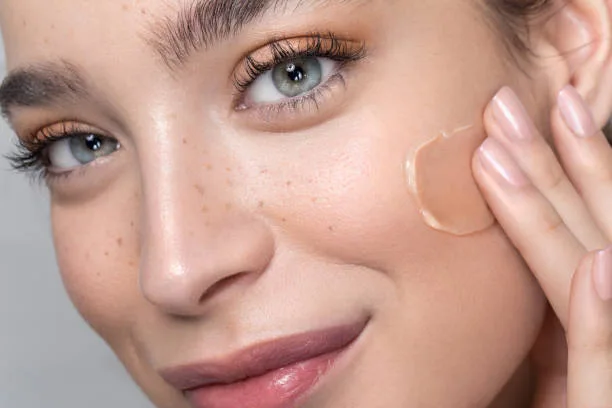Table of Contents
Introduction

Foundation, the cornerstone of makeup, holds the power to transform our complexion, elevate our confidence, and create a flawless canvas. Its significance in a makeup routine cannot be overstated. However, the quest for perfect coverage often leaves many perplexed, pondering the right shade, type, and application techniques.
In this comprehensive guide, we will delve into the importance of using foundation and equip you with the knowledge to apply it skillfully for impeccable coverage and a radiant glow.
Understanding the Importance of Foundation
Importance of Foundation:
- Foundation acts as a base, evening out skin tone and texture while providing a smooth surface for other makeup products.
- It conceals imperfections, such as blemishes, redness, and uneven skin tone, creating a flawless appearance.
- It offers protection by acting as a barrier between the skin and environmental pollutants.
Choosing the Right Foundation

- Foundation Types: Foundation comes in various types, each catering to different skin types. Liquid foundation is versatile, offering medium to full coverage and works well for most skin types, especially normal to dry skin, providing hydration and a radiant finish. Powder foundation is excellent for oily or combination skin, offering a matte finish and controlling shine throughout the day. Cream foundation suits dry or mature skin, providing a hydrating, dewy look while offering buildable coverage.
Mineral foundation, made of natural ingredients, is ideal for sensitive or acne-prone skin, as it’s non-comedogenic and gentle, offering light to medium coverage with a breathable feel. Selecting the appropriate foundation type based on your skin’s needs ensures a flawless finish while addressing specific concerns like hydration, oil control, or sensitivity. - Selecting the Correct Shade: Choosing the correct shade of foundation that matches your undertone is pivotal for a seamless and natural appearance. Undertones can be categorised as warm, cool, or neutral. Selecting a foundation shade that aligns with your undertone ensures that the product blends harmoniously with your skin, preventing a mismatched or ashy appearance.
For warm undertones, opt for foundations with yellow or golden tones, while cool undertones pair well with shades featuring pink or rosy hues. Neutral undertones can suit a range of shades that strike a balance between warm and cool tones. Matching your foundation to your undertone not only enhances the natural look but also ensures that the foundation seamlessly integrates with your skin, creating a flawless and undetectable finish.
Preparing Your Canvas – Steps for Application
Prepping the Skin:

- Cleansing: Initiating your makeup routine with a clean and well-moisturised face lays the foundation for a flawless application. Cleansing eliminates dirt, oil, and impurities, creating a clean canvas for makeup. Additionally, moisturising hydrates the skin, ensuring a smooth and even texture, allowing makeup products, like foundation, to glide effortlessly.
A properly moisturised face not only aids in the seamless application of foundation but also helps in preventing makeup from settling into fine lines or clinging to dry patches, ensuring a fresh and radiant appearance throughout the day. Therefore, the crucial first step of cleansing and moisturising paves the way for a polished and impeccable makeup look. - Primer: Utilising a primer in your makeup routine offers a multitude of benefits, primarily extending the longevity of your makeup and establishing a smooth base. A primer acts as a preparatory step by creating a barrier between the skin and makeup, ensuring prolonged wear by enhancing makeup adherence.
Moreover, it helps in blurring imperfections, minimising the appearance of pores, fine lines, and uneven texture, thus creating a flawless canvas for foundation application. The primer’s ability to control excess oil or hydrate dry areas further contributes to a balanced complexion, ultimately resulting in extended makeup wear and a polished, perfected look that lasts throughout the day.
Applying Foundation:

- Technique for Liquid Foundation: The application of liquid foundation can be achieved using brushes, sponges, or fingers for seamless and even coverage. To begin, dispense a small amount of foundation onto the back of your hand or onto a palette. Using a brush, start by dotting the foundation onto the centre of your face and blend outwards in gentle, sweeping motions, ensuring even distribution.
Alternatively, a makeup sponge can be used by dabbing the product onto the skin and softly pressing and blending in a stippling motion. Fingers can also work effectively, applying foundation in light tapping motions across the face and blending gently for a natural finish. Regardless of the tool chosen, blending thoroughly into the jawline and hairline is crucial for a flawless, well-blended foundation application. - Tips for Powder Foundation: When applying powder foundation, achieving a seamless finish relies heavily on the blending technique. Begin by choosing the right shade of powder foundation that matches your skin tone. Using a dense, fluffy brush, gently swirl it into the powder foundation and tap off any excess.
Start applying the powder in gentle, circular motions across the face, concentrating on areas that need more coverage. Blend meticulously, ensuring there are no harsh lines or uneven patches. Focus on feather-light strokes to prevent a heavy or cakey appearance. Continuously blend until the powder melds seamlessly with your skin, creating a flawless and natural finish that masks imperfections while still allowing your skin to breathe. - Blending and Layering: The significance of blending foundation seamlessly into the skin cannot be overstated; it’s the key to achieving a natural and flawless look. When applying foundation, whether liquid or powder, ensure thorough blending by using gentle, circular motions. This technique allows the product to meld seamlessly with your skin, blurring imperfections for an even complexion.
Additionally, layering the foundation lightly for buildable coverage is crucial. Rather than applying a heavy amount at once, start with a small quantity, gradually adding more only where needed. This method not only prevents a cakey appearance but also grants you control over the coverage, enabling a customised finish that looks natural and feels lightweight on the skin.
Tips for Achieving Perfect Coverage

Concealing and Colour Correction:
- Concealer: Concealer plays a pivotal role in achieving a flawless complexion by providing targeted coverage for blemishes, dark circles, and redness. It acts as a secret weapon, effectively camouflaging imperfections and uneven skin tones. By precisely targeting these problem areas, concealer enhances the overall appearance of the skin, imparting a fresh and revitalised look, seamlessly complementing the foundation for a perfected finish.
- Colour Correction: Colour correction techniques are a makeup artist’s secret to achieving a flawless complexion. By strategically using coloured concealers, such as green to counteract redness, orange to neutralise dark circles, or lavender to brighten dullness, specific skin concerns can be effectively tackled.
For instance, the green concealer, when applied sparingly over areas with redness, counterbalances the red tones, creating a more even skin tone. These techniques work on the principle of colour theory, neutralising and balancing out unwanted hues, allowing the skin to appear more balanced and radiant when layered with foundation and concealer.
Setting and Finishing

- Setting Powder: Setting powder serves as the ultimate ally in makeup application, locking the foundation in place and curbing excess shine. By lightly dusting this translucent powder over the foundation, it helps absorb excess oils, ensuring a matte finish and preventing makeup from sliding or creasing throughout the day. Its fine texture sets the foundation, enhancing its longevity and ensuring a smooth, flawless look that lasts, making it a must-have step for a shine-free, long-lasting makeup wear.
- Finishing Sprays: Setting sprays are a game-changer in the world of makeup, offering the dual benefit of prolonging makeup wear while imparting a natural, dewy glow. These sprays work by creating a fine mist that settles over the completed makeup look, effectively locking it in place for extended wear.
Additionally, setting sprays can provide a radiant finish, adding a subtle luminosity to the skin, and creating a fresh and dewy appearance that lasts throughout the day. Their lightweight formula ensures that makeup stays intact, offering a refreshed and natural finish, making setting sprays an indispensable final step in any makeup routine.
Additional Guidance

Tools and Brushes:
- Selecting the appropriate tools and brushes for applying foundation significantly impacts the finish and coverage of your makeup. For a sheer or natural finish, opt for a damp makeup sponge, such as a beauty blender, which works well in seamlessly blending liquid or cream foundations into the skin. Brushes with densely packed bristles, like flat-top kabuki brushes, provide fuller coverage and are excellent for buffing in liquid or powder foundation, offering a more polished look.
Fluffy, stippling brushes are ideal for achieving an airbrushed effect with liquid or cream foundations, creating a light, buildable coverage. Tailoring your choice of tools and brushes based on the desired finish—whether it’s sheer, medium, or full coverage—ensures a flawless application that meets your preferences and results in a beautifully blended and professional-looking finish.
Skincare Regimen:

- A solid skincare routine serves as the cornerstone for achieving a flawless makeup application. Properly cared-for skin forms the ideal canvas for makeup, allowing products to adhere better and perform optimally. Regular cleansing, moisturising, and exfoliating contribute to a smooth texture, balanced hydration, and a radiant complexion.
Additionally, skincare practices like using sunscreen protect the skin from damage, preserving its health and vitality. When the skin is nourished and well-prepped, makeup effortlessly glides on, ensuring a more even application and longer-lasting wear.
Ultimately, a diligent skincare regimen not only enhances the effectiveness of makeup but also promotes healthy, glowing skin, underscoring its crucial role in achieving a flawless and natural makeup finish.
Conclusion

Mastering the application of foundation is an art that involves understanding your skin type, choosing the right product, and employing the correct techniques. By following the steps outlined in this guide, you can achieve flawless coverage and a radiant complexion. Remember, the goal is not to mask your skin but to enhance its natural beauty. With practice and the right knowledge, you’ll confidently create a flawless base for your makeup, boosting your confidence and allowing your inner beauty to shine through.

FAQs
Why is choosing the right foundation important?
Choosing the right foundation is crucial because it serves as the base for your entire makeup look. The correct foundation shade and type that suits your skin tone and type will provide a seamless finish, concealing imperfections and creating a flawless canvas for other makeup products.
How can I determine my skin’s undertone to choose the correct foundation shade?
Determining your skin’s undertone involves identifying whether it’s warm, cool, or neutral. You can do a simple test by examining the veins on your wrist – blue or purple veins typically indicate a cool undertone, while greenish veins lean towards a warm undertone. Neutral undertones show a mix of both. Choosing a foundation with a matching undertone ensures a natural and harmonious finish.
What are the key steps for applying liquid foundation?
Applying a liquid foundation involves several steps for optimal coverage. Start with a clean, moisturised face, apply a primer for a smooth base, dot the foundation across your face, and blend using a brush, sponge, or fingers. Focus on areas that need more coverage and blend thoroughly for a seamless finish.
How can I set my foundation to make it last longer?
Setting your foundation is essential for longevity. After applying foundation and concealer, use a translucent setting powder to lock the makeup in place, especially in areas prone to oiliness or creasing. Gently dust the powder using a brush for a matte finish, or use a setting spray to enhance the makeup’s longevity and provide a natural, dewy look.
Is skincare important before applying foundation?
A good skincare routine is the foundation of flawless makeup application. Cleansing, moisturising, and applying sunscreen are crucial steps before makeup. Hydrated and well-prepped skin ensures smoother application and better adherence to the foundation, allowing for a more natural and radiant finish.



